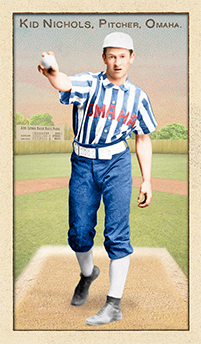- Series: Beginnings: 1880's
- City: Omaha
- Team: Omahogs
- League: Western Association
- Hall: National Baseball Hall of Fame
Charles Augustus Nichols (1869-1953). A right-handed, switch-hitting pitcher, Nichols played 15 major league seasons for 3 different clubs. Nichols had 11 seasons with 20 Wins or more, 10 consecutively, 7 of which exceeded 30. He quit MLB for 2 years to own & pitch for a minor league team, with whom he won another 48 games.
- Youngest to 300 Wins (30 years)
- 5x NL pennant winner
- His 361 Wins ranks 7th all-time
- Nichols has five known poses in the Old Judge canon.
- Elected to Hall of Fame: 1949
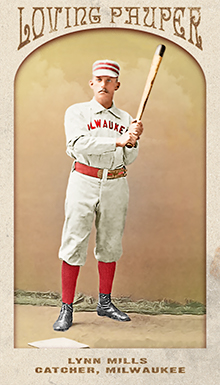
- Series: 1880s: Loving Paupers
- City: Milwaukee
- Team: Creams
- League: Western Association
Lynn Mills (1862-1937) was a native of Whitewater, WI. He moved to nearby Milwaukee to begin his professional baseball career with the Brewers in 1886. The team was also known as the Cream Citys or Creams after the distinctive local bricks made from a light-colored clay. We lack data on Mills' rookie season, but his performance in '87 was very positive. He batted .290, splitting time as a reserve at short and third. In 1888 the club transitioned from the Northwestern League to the Western Association and Lynn stayed with them through the '89 campaign. He got more playing time, but his average subsided a bit to .260 in '88 and .266 in '89. The following year Mills moved way out west to play for Spokane in the Pacific Northwest League where he had his most prolific year in all offensive categories. He hit .284 and had 103 base hits including 14 doubles as the regular catcher, a position he had played in Milwaukee. Sketchy minor league records indicate Mills returned to the midwest for the 1891 season with the Terre Haute Hottentots of the Northwestern League, but individual stats aren't available. Baseball Reference even shows him returning to Spokane, this time with the Indians of the Pacific National League in 1903, where the then 41-year-old is on the roster but with no record of positions played or batting statistics. It seems unlikely that Mills would have remained out of pro ball for a decade after showing good promise at the plate, especially for a catcher. It also seems unlikely that a youngster of his talent would have had no professional experience prior to age 24, when he is first shown to be with the Cream Citys. Sadly, extant minor league statistics leave too many gaps in our knowledge of the real contributions of stalwarts such as Lynn Mills.
- The Goodwin editors assert that Mills struggled with his defense in Milwaukee to the extent that, for the 1889 season, he ranked next-to-last in the Northwestern League in defense among catchers. Nevertheless, his ability to hit consistently would have assured him a job behind the plate for many teams in an era that devoured receivers who braved the job with little protective equipment
- Mills enjoys six known poses in the Old Judge canon
Auction History
Cartophilia
Old Judge Pose: 326-1
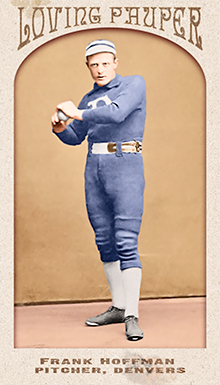
- Series: 1880s: Loving Paupers
- City: Denver
- Team: Grizzlies
- League: Western Association
Frank J. Hoffman began in professional baseball with the New Orleans Pelicans in 1887. Frank appeared in two games, is shown as having been age 25 at the time, and was the pitcher of record for both starts. He surrendered seven runs, none of them earned, and was 1 for 9 at the plate. He saw a bit more action the next year with the San Antonio Missionaries of the Texas-Southern League. He started eight games and was spectacular, going 7-1 with a .91 ERA. This was an abbreviated turn with the Missionaries. Although unrecorded by Baseball Reference, the Goodwin editors state that the San Antonio squad had begun the ‘88 season as the Austin Senators. The previous franchise in the Alamo city had gone out of business. On July 4 the Senators came to town, but they didn’t do any better drawing customers. After only the eight games, Hoffman was sold to the American Association’s Kansas City Cowboys. This opportunity provided Frank his sole chance to pitch in the big leagues. He couldn’t match his performance down south, going 3-9 with a still-respectable 2.77 ERA. He was released for the 1889 season and played for the Denver Grizzlies, where he was captured on camera by an Old Judge photographer for five known poses before returning to Texas with the Houston Mudcats for the 1890 campaign. He had a good enough ERA at 2.30, but lost 12 of his 17 decisions. His final known year in pro ball came in 1892 with the San Francisco Metropolitans of the California League. Team data show an eye-popping 39-37 record with an ERA of 1.72. It appears that Frank may have adopted San Francisco as his permanent home, having died there in 1916, 24 years after leaving baseball.
- Despite Hoffman's obscurity, he enjoyed one of baseball's most celebratory but confounding nicknames: The Texas Wonder. Because Frank was most likely born in Mississippi, one might surmise he earned the sobriquet during his 1888 career year with the San Antonio Missionaries, when he went 7-1 with a .91 ERA
Auction History
Cartophilia
Old Judge Pose: 228-1
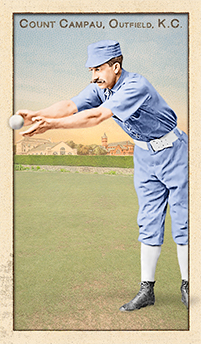
- Series: Beginnings: 1880's
- City: Kansas City
- Team: Blues (WA)
- League: Western Association
Charles Columbus Campau (1863-1938) may have been dubbed “The Count,” but he was the King of the Minors in the 19th century. No one matched his offensive output and he was prized especially for his defense. The scion of the French-Canadian founders of his native Detroit, Campau reigned in the society of the city and its ball fields. Educated at Notre Dame, he began playing there at an early age and soon came to dominate with his power and speed. He left Detroit with mentor Al Buckenberger to begin his pro career with Erie of the Interstate League in 1884. Thus began a two-decade tenure, mostly in the minors, that would take the Count to twenty different clubs including brief stints in the majors. His debut was back home with the Wolverines filling in for an injured Sam Thompson in ‘88. He stayed on with the newly constituted International League version of the Wolverines the following season and would have but one more turn in the big leagues, with the Browns in 1890 (save for two games with the Senators in ‘94). This would allow the hard-hitting Campau to claim a rare (unique?) distinction of leading the (minor league) International League and (major league) American Association in home runs in the same season. Charlie was known for his leadership skills and often served as on-field manager. Browns' owner Chris von der Ahe used him so in St. Louis that year and would call him “the best captain I have ever had.” Campau’s batting average could fluctuate, but his speed steadily improved to the point he was running foot races for prizes and was reputed to have never lost a match. The sketchy data of minor league stolen bases leaves a lot unknown but his feats were legendary. He swiped 100 bases in ‘87 and was renowned for a “home run” he hit by rounding the bases on a muffed pop-up in front of the plate.
- Campau continued in the minors through the 1905 season and umpired the following year. Never losing his love for speed, Charlie retired and went into the horse racing business and worked around the nation’s tracks in various capacities the rest of his life
- von der Ahe had sacked his prized manager for faithfully enforcing the owner’s own rules. The Count got a bit of revenge the next day, hitting an inside-the-park grand slam to the delight of St. Louis fans who rained down a deluge of cigars. Enough, Campau said, to open his own store
- Campau enjoys five known poses in the Old Judge canon
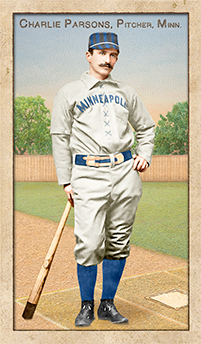
- Series: Beginnings: 1880's
- City: Minneapolis
- Team: Millers
- League: Western Association
Charles James Parsons (1863-1936) was a pitcher who got three try-outs with major league teams during a minor league career that spanned the latter half of the 1880s. He broke in with the Newark Domestics of the Eastern League in 1884 where, at twenty years old, he started two games, yielded just 3 earned runs in 15 innings and pitched to an 0-1 record. Charlie made an impression the following season for the Birmingham club of the Southern League, leading the team with a 10-13 record and an outstanding 1.48 ERA. On May 29, Parsons hurled the first no-hitter for those Barons, earning him a spot on the NL's Boston Beaneaters’ roster to begin the 1886 season. Assigned to pitch back-to-back games, Parsons lost both and was summarily sold to Rochester of the international Association, where he had an excellent year at 15-10 with a team-leading 1.12 ERA. Charlie’s sustained success in the minors earned him another spot in a major league rotation in 1887, this time with the New York Metropolitans of the American Association. In four starts, Parsons went 1-1 but gave up 17 earned runs (36 total runs for the error-prone Mets). By 1888, Charlie was suiting up for the Minneapolis Millers. Other than being immortalized in five known poses by a Goodwin photographer in his Millers uniform, Charlie started just one game in Minneapolis, surrendering two runs and finishing the game in a losing effort. In 1890 Parsons got one more shot in the majors with the Cleveland Spiders. Again, they only used him for two games and he lost his only decision.
- The Sporting News reported in its June 16, 1890 edition that Parsons had been signed by Jackson of the Tri-State League, but there is no evidence that he ever played professional baseball again
- Parsons was 25-24 with a 1.31 ERA in 51 minor league games, but just 1-4 with a 4.58 ERA in 8 major league games
- Charlie may have been a better hitter than pitcher. Although it’s a small sample, Charlie hit .333 (9 for 27) in his 8 ML games, knocking in two and stealing a bag for good measure
